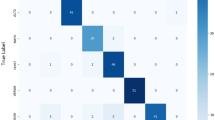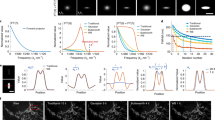Abstract
Purpose
Several cell detection approaches which deal with bright-field microscope images utilize defocusing to increase image contrast. The latter is related to the physical light phase through the transport of intensity equation (TIE). Recently, it was shown that it is possible to approximate the solution of the TIE using a low-pass monogenic signal framework. The purpose of this paper is to show that using the local phase of the aforementioned monogenic signal instead of the defocused image improves the cell/background classification accuracy.
Materials and methods
The paper statement was tested on an image database composed of three cell lines: adherent CHO, adherent L929, and Sf21 in suspension. Local phase and local energy images were generated using the low-pass monogenic signal framework with axial derivative images as input. Machine learning was then employed to investigate the discriminative power of the local phase. Three classifier models were utilized: random forest (RF), support vector machine (SVM) with a linear kernel, and SVM with a radial basis function (RBF) kernel.
Results
The improvement, averaged over cell lines, of classifying \(5 \times 5\) sized patches extracted from the local phase image instead of the defocused image was \(7.3\) % using the RF, \(11.6\) % using the linear SVM, and \(10.2\) % when a RBF kernel was employed instead of the linear one. Furthermore, the feature images can be sorted by increasing discriminative power as follows: at-focus signal, local energy, defocused signal, local phase. The only exception to this order was the superiority of local energy over defocused signal for suspended cells.
Conclusions
Local phase computed using the low-pass monogenic signal framework considerably outperforms the defocused image for the purpose of pixel-patch cell/background classification in bright-field microscopy.


Similar content being viewed by others
References
Agero U, Monken CH, Ropert C, Gazzinelli RT, Mesquita ON (2003) Cell surface fluctuations studied with defocusing microscopy. Phys Rev E 67(5):051904
Ali R, Gooding M, Szilágyi T, Vojnovic B, Christlieb M, Brady M (2012) Automatic segmentation of adherent biological cell boundaries and nuclei from brightfield microscopy images. Mach Vis Appl 23(4):607–621
Ali R, Szilagyi T, Gooding M, Christlieb M, Brady M (2010) On the use of low-pass filters for image processing with inverse Laplacian models. J Math Imaging Vis 43:1–10
Becattini G, Mattos L, Caldwell D (2011) A novel framework for automated targeting of unstained living cells in bright field microscopy. In: Proceedings of the IEEE international symposium on biomedical imaging: from nano to macro, pp 195–198
Boukerroui D, Noble JA, Brady M (2004) On the choice of band-pass quadrature filters. J Math Imaging Vis 21(1–2):53–80
Breiman L (2011) Random forests. Mach Learn 45(1):5–32
Chang CC, Lin CJ (2001) LIBSVM: a library for support vector machines. ACM Trans Intell Syst Technol 2(3):27:1–27:27. Software available at http://www.csie.ntu.edu.tw/~cjlin/libsvm
Felsberg M, Sommer G (2001) The monogenic signal. IEEE Trans Signal Process 49(12):3136–3144
Hamilton WR (1844) II. On quaternions; or on a new system of imaginaries in algebra. Lond Edinb Dublin Philos Mag J Sci 25(163):10–13
Sjöström Jesper P, Frydel B, Wahlberg L (1999) Artificial neural network-aided image analysis system for cell counting. Cytometry 36(1):18–26
Khoshgoftaar T, Golawala M, Van Hulse J (2007) An empirical study of learning from imbalanced data using random forest. In: Proceedings of the IEEE International Conference on Tools with, Artificial Intelligence, vol 2, pp 310–317
Long X, Cleveland W, Yao Y (2005) A new preprocessing approach for cell recognition. IEEE Trans Inf Technol Biomed 9(3):407–412
Long X, Cleveland W, Yao Y (2006) Automatic detection of unstained viable cells in bright field images using a support vector machine with an improved training procedure. Comput Biol Med 36(4):339–362
Mellor M, Brady M (2005) Phase mutual information as a similarity measure for registration. Med Image Anal 9(4):330–343
Morrone MC, Ross J, Burr DC, Owens R (1986) Mach bands are phase dependent. Nature 324(6094):250–253
Mualla F, Schöll S, Sommerfeldt B, Maier A, Hornegger J (2013) Automatic cell detection in bright-field microscope images using SIFT, random forests, and hierarchical clustering. IEEE Trans Med Image 32(12):2274–2286. doi:10.1109/TMI.2013.2280380
Nattkemper T, Ritter H, Schubert W (1999) Extracting patterns of lymphocyte fluorescence from digital microscope images. Intell Data Anal Med Pharmacol 99:79–88
Popescu G (2011) Quantitative phase imaging of cells and tissues. McGraw-Hill, New York
Poularikas AD (2010) Handbook of formulas and tables for signal processing, vol 13. CRC Press, Boca Raton, FL
Russell B, Torralba A, Murphy K, Freeman W (2008) Labelme: a database and web-based tool for image annotation. Int J Comput Vis 77(1):157–173
Scholkopf B, Smola AJ (eds) (2001) Learning with kernels. MIT Press, Cambridge, MA
Stein EM (1970) Singular integrals and differentiability properties of functions Elias M. Stein, vol 2. Princeton University Press, Princeton, NJ
Teague MR (1983) Deterministic phase retrieval: a green’s function solution. J Opt Soc Am 73(11):1434–1441
Tscherepanow M, Zöllner F, Hillebrand M, Kummert F (2008) Automatic segmentation of unstained living cells in bright-field microscope images. In: Advances in mass data analysis of images and signals in medicine, biotechnology, chemistry and food industry (Lecture notes in computer science), vol 5108. Springer, Berlin, pp 158–172
Acknowledgments
The authors would like to thank the Bavarian Research Foundation BFS for funding the project COSIR under contract number AZ-917-10. In addition, we gratefully acknowledge funding of the Erlangen Graduate School in Advanced Optical Technologies (SAOT) by the German Research Foundation (DFG) in the framework of the German excellence initiative.
Conflict of interest
Firas Mualla, Andreas Maier, Stefan Steidl, Rainer Buchholz, and Joachim Hornegger declare that they have no conflict of interest. Simon Schöll is employee of ASTRUM IT GmbH, Erlangen, Germany. Björn Sommerfeldt is financed by the Bavarian Research Foundation until the end of December 2013.
Author information
Authors and Affiliations
Corresponding author
Rights and permissions
About this article
Cite this article
Mualla, F., Schöll, S., Sommerfeldt, B. et al. Using the low-pass monogenic signal framework for cell/background classification on multiple cell lines in bright-field microscope images. Int J CARS 9, 379–386 (2014). https://doi.org/10.1007/s11548-013-0969-5
Received:
Accepted:
Published:
Issue Date:
DOI: https://doi.org/10.1007/s11548-013-0969-5




